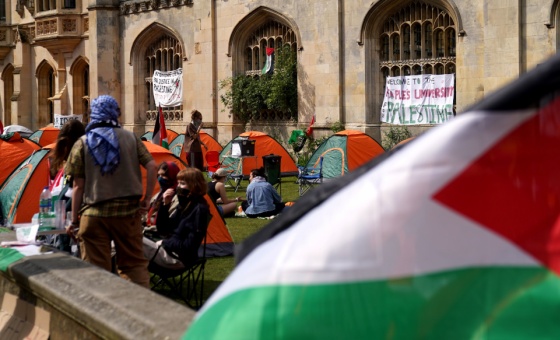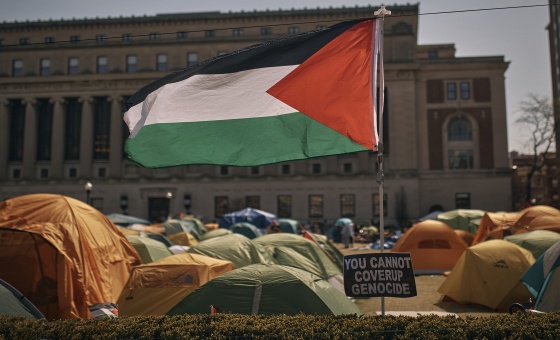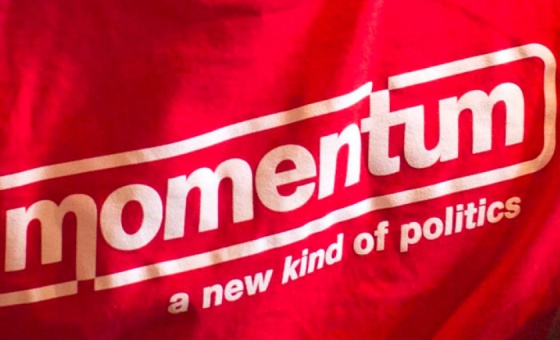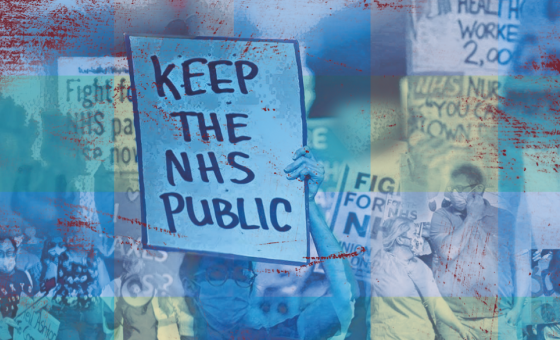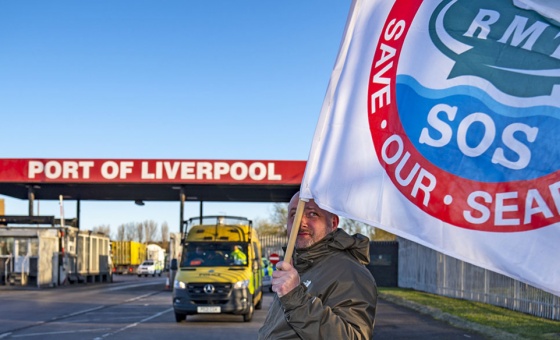This is the last article you can read this month
You can read more article this month
You can read more articles this month
Sorry your limit is up for this month
Reset on:
Please help support the Morning Star by subscribing here
“I CANNOT say I am impartial, I am partial. I am on the side of the oppressed,” Kurdish artist and journalist Zehra Dogan tells me as she hand-rolls a cigarette in the garden of the Kurdish Community Centre in north London.
It is a warm spring evening and the centre is a hive of activity. Much talk is of the recent events at Amnesty International’s London HQ where protesters occupying the human rights organisation’s reception area were violently removed by police just days before.
They were protesting over Amnesty’s continued silence on the plight of the Kurds and in particular the continued isolation of PKK leader Abdullah Ocalan.
As many as 7,000 are believed to be on hunger strike, mainly in Turkish prisons, although two of them are also in the centre as part of a solidarity action.
Dogan recently dedicated her Index on Censorship Freedom of Expression Award to the hunger strikers, saying: “In my country deputy Leyla Guven and thousands of prisoners are on hunger strike and they have reached a critical stage. Please share their story.”
She is about to launch an exhibition at the Tate gallery — a remarkable achievement for someone who until February was in a Turkish prison.
She was jailed for a painting which depicted the destruction of the largely Kurdish city of Nusaybin in Turkey’s south-east, which had been under military curfew after a resistance uprising.
The devastation was shocking. Around 80 per cent of the city was flattened and homes were reduced to rubble after Turkish military attacks.
In the 21 months following the collapse of peace talks in July 2016, at least 2,748 people were killed. Around 100,000 lost their homes, and up to 400,000 were temporarily displaced in the largely Kurdish south-east.
Dogan was on the front line reporting from Nusaybin, a deliberate decision made by her and her colleagues to expose the activities of the Turkish state against the country’s Kurdish population.
“In Nusaybin, in Cizre, I witnessed the massacre of many women. Many of our friends also saw this. And we exposed why this massacre happened and we also wrote articles and news that made it clear that we were not going to be on the side of the government’s war.”
Because of this, the Jinha news agency that was founded by Dogan and her friends was shut down by presidential decree, one of the hundreds of media organisations shut down across Turkey.
She turned to painting as her articles were being ignored by the mainstream press and she saw this as a powerful way of expressing the violence of the Turkish state.
“The news reports I wrote had no effect. I decided that the only way I could express what was happening around me would be through painting,” Dogan says.
It has had a similar visual impact to Picasso’s Guernica, which brought the world’s attention to the bombing of the Basque town by German and Italian fascists.
“For this is the reason I was targeted. Nine people gave evidence against me. They gave statements under torture. The police forced them to sign statements.
“Because I reported the journal of a 10-year-old kid and did the picture of the destruction of Nusaybin I was arrested.
“The judge that gave me the sentence questioned why I painted Turkish flags on the destroyed walls. He said that because of this I wanted to incite the people to hatred against the state,” she explains. “But I didn’t create something from my imagination. Turkish soldiers really put the flags on the walls.”
Dogan insists that it is the soldiers who should have been punished for their actions. It is they who are driving the young to take up arms because of their actions, their hatred and the continued oppression of the Kurdish people.
“To destroy something, to occupy it and put a flag in it is a crime. Their form of justice is wrong,” she explains. “But instead it was me who was punished. I was jailed for nearly three years.”
Being in jail didn’t stop Dogan — she says she refused to be silenced and continued to write about female political prisoners and documented human rights abuses. And despite the prison authorities refusing to give her art material she continued to paint.
Dogan used dyes made from crushed fruit, herbs smuggled from the prison kitchen including turmeric and she asked her fellow prisoners for their period blood which she used for her paintings made on newspapers and milk cartons.
She said that for thousands of years period blood has been branded “disgusting.” Dogan explains that she was also seen as “disgusting,” being labelled a terrorist by the government.
So she turned this around by using the period blood in paintings to highlight the “disgusting” crimes committed by the Turkish state.
She was jailed for nearly three years on terrorism charges — the catch-all term for anybody who opposes the rule of authoritarian President Recep Tayyip Erdogan.
While behind bars the anonymous artist Banksy posted a mural in a New York wall in protest at Dogan’s imprisonment.
It showed multiple black tally marks resembling jail bars, each representing a day Dogan has spent in prison.
Dogan’s painting was above the mural, with the words “Free Zehra Dogan” underneath it. Banksy said that he had painted pictures more worthy of a prison sentence.
“Sentenced to nearly three years in jail for painting a single picture,” he posted on social media.
I asked Dogan about the impact of Banksy’s gesture.
“Banksy took my small painting and made it big,” she explains.
“From all over Europe I started receiving letters saying: ‘We had no idea what the Turkish state was doing to you until the Banksy painting’ and saying: ‘We are sorry we didn’t know.’
“I received a lot of letters from countries where human rights violations are happening which said we are living exactly the same things you are living and this picture is expressing us as well.”
The support and solidarity she received made her “very strong,” she said, and showed her that she could engage in political struggle through her art.
“Art is undoubtedly political because humans are political in nature,” she says. “And me directly as a political person, as a Kurdish person my art is also political.
“And it is art that takes a side. When I do a drawing I don’t only think or art discipline, I also think about what I need to explain, what I need to tell.”
Dogan’s work as an artist and a journalist are intertwined. She argued in court that her painting was journalistic work after it was posted on social media.
She was one of the founders of the Jinha news agency, a media organisation run by women who put themselves on the front line. It was launched on March 8 2012, International Women’s Day.
“Kurdish journalism has a 100-year tradition, it’s been around for 100 years,” Dogan says, explaining that the first female editor of a newspaper was Kurdish.
“Of course for the woman, especially the Kurdish woman who has been living under male dominance in the patriarchal system for the past 5,000 years, this was not enough.”
She spoke about the alternative press which, while doing some very good work in terms of the human rights violations and atrocities committed in Turkey, had some serious problems in reporting issues affecting women.
“When doing their reports about sexual harassment or rape the language being used was a very male-dominated language,” she says.
“We established Jinha with just five people as a women-only news agency. The cameraperson was a woman, the journalists were women. They were all volunteers.
“In a very short time the journey we started with five people continued with hundreds of people. In Syria, in Kobane, in Qamisli, in Sleimani. We started in Diyarbakir and then in Istanbul and Izmir we opened branches.”
Dogan says that there was a famous quote from the author Virginia Woolf who said that women should write regardless of what men think. She said women should have a room of their own.
“We took this quote as inspiration, but we used it a bit differently as Virginia Woolf said you should have a room of your own but we refused those terms,” she says explaining that their journalism was done in the field.
“As a woman journalist, the best way to oppose this is to be at the front. And to be a peace journalist in the war front.”
One of the first initiatives started by Jinha to challenge sexism within the industry was producing a women’s dictionary for journalists, which exposed the use of language and the way issues are reported in the Turkish press.
“We woke up every morning and we took all the newspapers in front of us, Cumhuriyet, Hurriyet, Milliyet etc.
“We searched through their news articles and we emailed them, wrote to them and said — here you are using a language that is male-dominated.”
It worked as often articles were corrected and the language style changed, even if the newspapers refused to acknowledge that it was because of pressure from the Jinha journalists.
If they refused or ignored the request, Dogan says Jinha would make a news article and expose the newspaper for writing a sexist article.
Jinha did not focus just on news about and for women, she explains. This would have meant removing themselves from the field of struggle.
“Had we been a woman’s news agency just doing news about women it would have been an agency that just talks to itself and we could not have moved forward.
“In this manner the news the reports were done by women but also with the perspective, the idea that it’s targeted towards men as well so men can change their view of women through the news we produced.”
Because Jinha chose to do its journalism from the front line it became a target for the Turkish state.
“We would have been undangerous and weak women and we wouldn’t have caused any danger to the system.
“But in this war we chose to take a side,” she says as she explains that Jinha was shut down.
“If we had just accepted the closure and said there is nothing that we can do, we would have accepted the common women’s role given to us. But we refused to accept this.
“They took our computers, they took all our equipment, they closed down our agency. But we found another place and we didn’t have any money in our pockets.
“They closed that as well. Then we established Jin News and which continues today.”
We discuss the oppression of journalists in Turkey. Dogan had heard of my recent detention and deportation, banned as a threat to national security.
“There is a consistency in Turkey in violations and the numbers of journalists that are in jail. They are number one at this and at no time do they want to give this to anyone else being number one at this,” she says laughing ironically.
“They are always number one. This is the most consistent thing in the politics of Turkey.
“Unfortunately hundreds of journalists are in prison in Turkey, but Erdogan says they are not journalists, they are terrorists. But we all know this very well — we are all journalists.
“This period is a big test for us as journalists because things will change because of us. What’s happening now will be changed by the journalists,” she says.
Her eyes light up when we discuss the new Journalists for Democracy in Turkey and Kurdistan initiative. She said she was very excited to hear about it.
“We as Kurdish journalists have been wanting this for a long time,” she says. “We want our voices to be heard. This could be a very big revolution in journalism. This is very, very important.
“Real history is written by journalists,” Dogan insists. “Therefore in these oppressive times, in order to write the real history, all the journalists need to show solidarity.”
Zehra Dogan's installation is part of Who Are We? project which runs from May 21-25 2019 at the Tate Exchange, Tate Modern, Bankside, London SE1 9TG.




